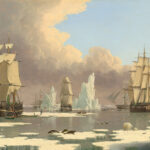5 June 1866: Crew members of the whaler Diana (Hull) climb an Arctic hillside and leave a memento of home

A sketch of the cairn by the Diana’s doctor, Charles Edward Smith (Smith 1922).
Charles Edward Smith. 1922. From the Deep of the Sea. Ed. Charles Edward Smith Harris. London: A. and C. Black. Get it:
.Unedited excerpt
If an excerpt is used in the book, it will be shorter, edited and, where applicable, translated.
The surgeon of the Intrepid, Mr. Galloway of Dundee, a student of Glasgow University, called upon me. Saw great numbers of eider ducks on the floe edge. They are beautiful birds, but extremely shy. The cry of this species of duck is exactly like the bark of a dog.
Went with George Clarke to one of the islands near by. Had a terrible climb up the sides of the rocks, which were covered with snow, and then up the sides of the loftiest peak on the island. I never had such a climb in my life, and I wonder how we succeeded in scaling the precipice. We were frequently up to the thighs in snow, or at times crawling along the brow of a precipice with only a few inches of frozen snow between our feet and the slippery rocks below.
After an hour’s hard work we reached the summit, and there found a cairn of stones which evidently had been raised there many years ago by visitors such as ourselves. We repaired it, and wrote the ship’s name and port upon an adjacent snowdrift for the information of anyone who might visit the cairn before next winter.
We had a most magnificent view of the ocean and numerous islands and icebergs, the sun shining brilliantly and the sky without a cloud. By means of a very powerful telescope which one of the Shetland men had carried up we could see the three steamers ahead of us. Utter silence and desolation on all sides. Patches of dead heather and moss where the rocks were sheltered from the snow, and a peculiar straggling plant with bright purple blossoms.
Our return was much more expeditious than our outward journey. The easiest method of descent was to squat on one’s hams and slide from top to bottom of the hills. Seeing a white object upon a large boulder, we looked at it with the telescope, and lo! ’twas a ptarmigan. George Clarke crept near and shot it. ‘Twas a beautiful bird, snow-white (except for a few black feathers in the tail), and with brilliant red wattles over its eyes.
Returned to the ship at midnight. The sun shone brilliantly all night. Noticed from the ship’s side a great number of large medusae, so large that the circulation of drops of water could be seen quite easily with the naked eye as they floated past.
Comment
Comment
Which island? Was the raising of cairns at that time more of a Shetland than a Hull pursuit?
Something to say? Get in touch
Similar
 19 February 1866: The Diana, Hull’s first steam-assisted whaler and its last of any nature, leaves on its fateful voyage to the Arctic
19 February 1866: The Diana, Hull’s first steam-assisted whaler and its last of any nature, leaves on its fateful voyage to the Arctic 30 June 1866: The crew of the Diana of Hull kill and process two right whales – a small fortune – in Melville Bay, off northwestern Greenland
30 June 1866: The crew of the Diana of Hull kill and process two right whales – a small fortune – in Melville Bay, off northwestern Greenland 10 January 1867: Short of fresh provisions amid Arctic ice, the surgeon of the Diana of Hull decides to blame (Yorkshire) tea for symptoms of scurvy among the crew
10 January 1867: Short of fresh provisions amid Arctic ice, the surgeon of the Diana of Hull decides to blame (Yorkshire) tea for symptoms of scurvy among the crew
Comment
Comment
Here’s an image:
In 1613 Andrew Barker, an Elder Brother of Hull’s Trinity House & the captain of the Heartsease, took aboard an Inuit in a kayak off Greenland. The Inuit died 3 days later, but the 12-ft skin-covered kayak & its contents were brought home to Hull & are displayed in Trinity House. pic.twitter.com/7HsFqlTpj5— Former Lord Mayor of Kingston Upon Hull (@LordHull) July 16, 2020
Capt. Henry Watson, of the ship True-love, having brought a native of Davis’s Straits to Hull, he has exhibited his canoe, in the Old Dock, where he displayed his wonderful art in the management of that boat, so peculiar to his country, and his dexterity with the harpoon and lance (Phillips 1816).
Something to say? Get in touch
Search
Donate
Music & books
Place-People-Play: Childcare (and the Kazookestra) on the Headingley/Weetwood borders next to Meanwood Park.
Music from and about Yorkshire by Leeds's Singing Organ-Grinder.



 Bluesky
Bluesky Extwitter
Extwitter